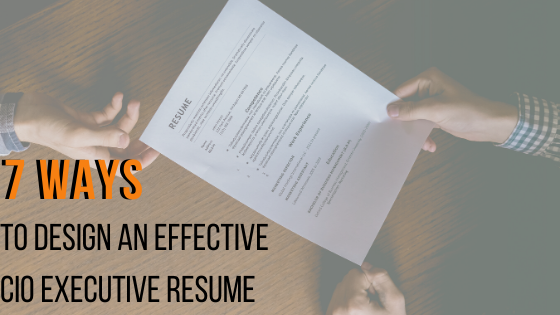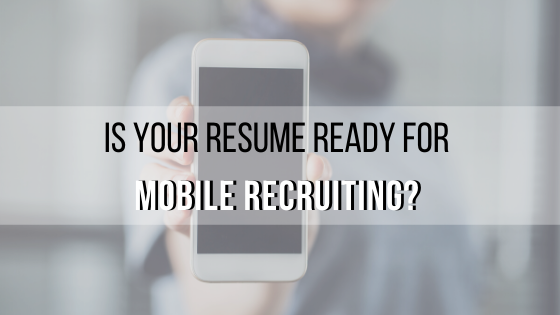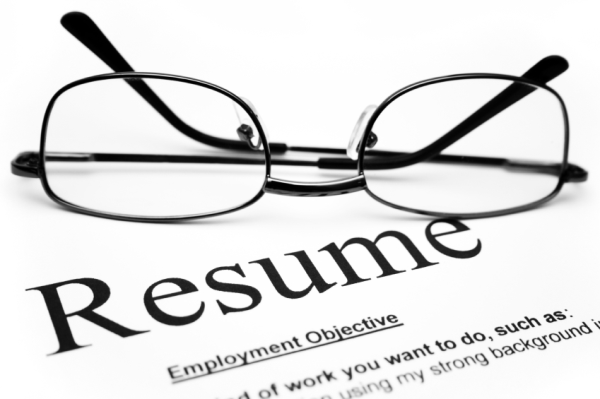
Designing a high-impact executive resume as a CIO, or if you are evolving to become an information technology (IT) executive, is one of the most effective means of communicating your skills, promoting your achievements and demonstrating how you are the best candidate for a coveted CIO role. The key difference in creating an effective CIO executive resume versus a professional-level IT resume is to integrate human capital management skills and fiscal acumen abilities alongside technical hardware, software and cloud solutions throughout the resume. The bottom line is, as an IT executive, you need to demonstrate how you can utilize human and technological resources to improve corporate profitability. Period.
Here are 7 ways you can design an effective CIO executive resume
1. Practice what you preach.
IT recruiters tell me that nothing irks them more than an IT executive that does not include a website or social media links on their resume. I am told that a CIO or upcoming IT Executive that has very little to no presence on the internet, or worse, a poor presence on the web, demonstrates that either they are not a lover of technology or that they are a poor promoter of themselves.
2. Gravitate from tactical implementation and graduate to a strategic perspective.
When compiling your CIO resume, be sure that you showcase your corporate contributions to the top line, expense line items, workflow productivity, and the bottom line. Graduate from citing specific tactical skills and responsibilities, that can be common in a staff-level or middle management information technology resume, to outlining initiatives where you have added value and projects that you have led to achieving results. The key with a CIO resume, as with all c-level resumes is to include the long-range effects of your work in addition to the short-term results. You want to show how you can strategize on the big picture and cause movement with what is directly in front of you.
3. Showcase soft skills alongside strong financial achievements.
Don’t have readers get lost in your resume with a list of systems, software, hardware and applications in which you have expertise. Your CIO executive resume will be read by technical and non-technical types and you must cater to both audiences. We know you have impressive credentials and achievements, but don’t let the metrics overshadow your human capital accomplishments. Outline how you incorporated technology and human capital to drive workflow productivity, revenues, and profits for the business.
4. Demonstrate that you can attract high-quality talent and lead teams to achieve results.
Effective IT Executives not only manage technology, but they successfully manage people to manage technology to bring results. Successful CIOs set up deals, influence key decision-makers, nurture vendor relationships, possess sharp negotiation skills and attract key talent. Do not lose sight of the importance of your people skills contributing to your past and future success.
5. Use appropriate context when communicating with prospective employers. Talking about your biggest achievement is not always best.
Reframing it, however, to showcase your accomplishments in a way that is digestible for the prospective employer is always preferred. If you saved $7 Million dollars on one initiative within a $125 Million dollar employer, but now you are applying to an $18 Million firm, you may be perceived as being overqualified for this next position. Either choose achievements that are within the fiscal scope of the prospective company, or consider using percentages to outline your accomplishments. Another tactic to use is to focus on downplaying or highlighting the size of regional budgets, global budgets, business lines, or other business entity sizes to match the prospects.
6. Showcase results and downplay technical jargon.
Outline your technical and human capital achievements in a universal language and not just financial jargon. Appeal to the many types of audiences by whom your resume will be read. You may be most comfortable speaking in acronyms or technical vernacular, but not all CEOs and executive hiring teams are aware of techspeak. I suggest that you speak about technology in approachable terms to be understood by many types of executive management. This will demonstrate your ability to work with non-technical types in a subliminal manner.
7. Be what they want but never lose yourself in your resume.
The content in your resume, social media profiles, and communications should be congruent with your personality, beliefs and work style, while still meeting the needs of the prospective employer. Ensure your resume will be in line with the person who shows up on the interview. Always be who you are on paper, online and in person.
The resume of a successful Chief Information Officer must not only demonstrate that you know the why and how behind the technology, but it also must tell a story on how you have communicated effectively with managers, lenders, shareholders, vendors, and other key partners. Frankly, the best CIOs will show how they identify and implement current technology that breeds financial benefits that improve the company’s position within its marketplace. strategically, design and implement business plans and inspire leadership within the financial departments and with the executive management team to solidify its company’s future.










.png?width=690&name=Job%20Search%20Adivce%20(1).png)
 TURN THAT FROWN UPSIDE DOWN. Nobody wants to bring in an employee in a bad mood. I’m actually surprised at how many cover letters we receive where candidates blatantly discuss their disgruntled feelings over being passed over because they are unemployed. If you’re depressed and show it, you will be disqualified regardless of your employment status.
TURN THAT FROWN UPSIDE DOWN. Nobody wants to bring in an employee in a bad mood. I’m actually surprised at how many cover letters we receive where candidates blatantly discuss their disgruntled feelings over being passed over because they are unemployed. If you’re depressed and show it, you will be disqualified regardless of your employment status.  CREATE YOUR OWN JOB. So you don’t have formal job, create one! Yes, create your own job. I do it all the time. Isn’t that the mark of a good marketer? When I’m in between jobs, I do some consulting. Over the past few years, I’ve developed a personal brand to impress marketability and hire-ability. I get out there and create jobs, even if it means working for friends and small businesses at a discounted rate, working is better than being depressed about not working. Make yourself look busy by being busy. If I know small businesses that need marketing, I barter my services or work cheaply to keep the work ball rolling. You’re not getting paid right now, so don’t worry so much about the money as getting yourself off the pity pot and back into work mode.
CREATE YOUR OWN JOB. So you don’t have formal job, create one! Yes, create your own job. I do it all the time. Isn’t that the mark of a good marketer? When I’m in between jobs, I do some consulting. Over the past few years, I’ve developed a personal brand to impress marketability and hire-ability. I get out there and create jobs, even if it means working for friends and small businesses at a discounted rate, working is better than being depressed about not working. Make yourself look busy by being busy. If I know small businesses that need marketing, I barter my services or work cheaply to keep the work ball rolling. You’re not getting paid right now, so don’t worry so much about the money as getting yourself off the pity pot and back into work mode. 
 Feeling a little uncomfortable in interviews? Don't feel like you're getting the respect you deserve? Might be time for a little training in interview etiquette. Don't worry, it isn't hopeless, here are a few ideas to get you back on your toes and earn the attention of your interviewer positively. Tell employers to pick you, after fine tuning your interview skills.
Feeling a little uncomfortable in interviews? Don't feel like you're getting the respect you deserve? Might be time for a little training in interview etiquette. Don't worry, it isn't hopeless, here are a few ideas to get you back on your toes and earn the attention of your interviewer positively. Tell employers to pick you, after fine tuning your interview skills. 